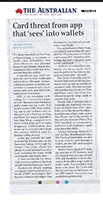In: RFID
December 27th, 2015
Consumer Alert – RFID protective cards and devices are not created equal

RFID Protective cards – understand the difference before you buy.
Over the past few months it has come to our attention that consumers are judging the effectiveness of the RFID protective cards they are purchasing against retail point of sale terminals.
Based on this method of testing these RFID Protective cards give the appearance of being very effective at blocking a transaction being processed and have received a number of very positive reviews.
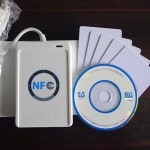
Standard off the shelf NFC / RFID reader that can be easily purchased online for under $100
The truth is that if you place two PayPass cards together and present them to a retail (tap & go) terminal the transaction will NOT go through. This is so the consumer can make the decision of which card they wish to present to the terminal. Don’t be fooled though, any standard reader (like the one in the image to the right) that can be purchased online will not give you this option and will take the information off the first card that responds to its requests. These readers have anti-collision software so it does not matter how many cards are being interrogated it will always get at least one.
The criminals who perpetrate this electronic pickpocket crime would rarely use a retail style (tap & go) terminal to skim, they are more likely to use a standard off the shelf reader and ‘amp up’ the antenna and signal strength.
The way in which some of these cards are marketed and the terms that they use to boost the hype imply that the cards are loaded with top secret and patented technology some even drop names such as “NASA” to increase their worth.
The truth is actually quite different. Often a standard programable RFID card worth about $0.75 is programmed with essentially garbage in an attempt to confuse the terminal which is trying to interrogate it. This has been shown to be inconsistent in its protective ability and thus cannot reliably support the claims that are being made.
As there is no regulatory body governing the standards of products in this field, it has been left open for anybody to jump on board and try to make a quick dollar. The few companies that have invested significantly in research and development to effectively protect the consumer have been left trying to defend and differentiate their products from those who have clearly blurred the lines and cannot support or prove the claims that are being made. The sooner this industry can be regulated the better.

Where does this leave you? the best advice is to research the product you are considering purchasing.
If it claims to Jam does it have FCC approval?
If it claims to have patented technology is there a reference to a patent? (don’t be fooled by a ™ next to a word, that does not constitute a patent but merely a logo or term being trademarked)
If it claims to be active does it have a battery?
As a consumer you must do your research and due diligence until there is a regulatory body who can help govern the claims being made. Protecting your identity from theft is a serious business and you should only look for companies and products who are serious about protecting your data & not who just want to jump on the band wagon for a quick dollar.
The decision is ultimately yours as to how much worth protecting your personal data is to you.
Beware, Be Aware and Stay Vigilant.

PRESS Release: SYDNEY – 10TH JUNE 2015 –
‘Tap and Gone’ – Electronic Pickpockets costing Aussies up to $439m
ARMOURCARD, an Australian company dedicated to the prevention of wireless skimming, has revealed Aussies could be losing as much as $439 million a year to ‘Electronic Pickpockets’, following a study into the extent of the criminal activity.
The survey revealed that one in seven Australians (14%) have either been affected themselves or know someone that has been a victim of electronic skimming – a type of credit card fraud, where criminals extract your card details using RFID or NFC technologies.
The report also found a fifth of Aussies (20%) are completely unaware this crime exists.
Tyler Harris, Co-Founder and Director at AMOURCARD, believes that things will only get worse for consumers, if we don’t address this issue proactively.
“Wireless technologies, such as ‘Tap and Go’, have made life easier for shoppers and retailers. However, the same technology has become a target for criminals looking to exploit it for personal gain,” said Harris.
“Anyone with a NFC enabled smartphone can download any number of free apps which turn their phone into a device capable of retrieving personal information and data from ‘tap and go’ cards and ePassports. It is an invisible crime that often goes unnoticed until it is too late.”
The study also revealed the true extent of the crime could be even greater, with Aussie not knowing they have been robbed. Over half (51%) of Australians admitted they wouldn’t notice if small amounts of money went missing from their accounts, with the average Australian adult able to lose $28.49 without noticing. This equates to a potential loot of $519M available to criminals.
“The threat of being robbed $20, $30 or even $100 often isn’t at the top of our minds, but we are all aware that it happens. What is surprising is this is only the tip of the iceberg and consumers are yet to see the threat that lurks below the waterline,” added Harris.
As more items become RFID or NFC enabled – such as Social Security cards, medical cards, library cards, driver’s licenses and national identity cards – the likelihood of being skimmed will increase. These cards contain a lot of personal information and data, which hackers can exploit. This stolen information aids criminals in the profiling of individuals and can lead to identity theft as well as fraudulent fiscal gain.
“We’ve looked at this technology being rolled out across the globe and have found that personal information, such as your name, age, date of birth and address can easily be attached to the RFID or NFC microchips. Access to this information will only aid criminals in stealing your identity. Until the technology is proved 100% safe it only makes sense to protect yourself,” concluded Harris.
August 28th, 2014
Mythbusters banned from talking about RFID by card issuing companies

Mythbusters Banned from airing RFID story
The hit Discovery channel show Mythbusters recently wanted to air an episode about how trackable and hackable RFID chips were. It’s still not clear as to why they were not allowed to proceed in airing the show but as Adam Savage the co-host of the hit show eludes to in this interview, some very powerful people / companies made sure that it would never air.
Everyone would’ve learned more about the technology that?s invisibly invading our lives and the vulnerabilities surrounding this global uptake and usage of these technologies on us by the big end of town.
Talk about shutting down and closing ranks…… it seems the card issuing companies and RFID manufacturers really don’t want us (we the people) to know how vulnerable this technology is and how easy it is to hack / skim.
Thanks Mythbusters for trying to expose this vulnerable technology and although your piece did not go live on the Mythbusters show the surrounding hype about the show being pulled shows just how vulnerable we are to skimming.
The only way to protect your personal data is with the latest technology found in an ARMOURCARD. The first Active RFID & NFC protective device.
BUY an ARMOURCARD NOW and get protected
By Tyler Harris
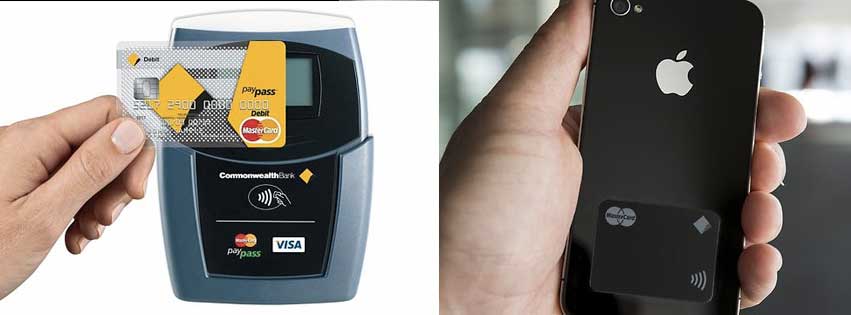
Contact-less technology adoption in Australia is exceeding expectations
Australia has long been a testing ground for new technologies and products just like contact-less technology found in credit cards & ePassports, the isolation of the continent in relation to North America & Europe probably contributes to the notion of a testing ground that can give real insights into the future global roll-out of products (plus they can contain any issues before they become global issues). An example of this (let me digress for a moment to prove the point), is the automotive industry here in Australia, we have more marks or manufactures in this country than in the USA or Europe.
ABARTH, ALFA ROMEO, ASTON MARTIN, AUSTIN, ACURA
BEDFORD, BENTLEY, BOLWELL, BUFORI,
CADILLAC, CATERHAM, CHERY, CHEVROLET, CHRYSLER, CITROEN
DAEWOO, DAIHATSU, DODGE
FIAT, FORD
GEELY,GREAT WALL
HINO,HUMMER, HOLDEN (GM) HYUNDAI, HONDA
INFINITI, ISUZU
JAGUAR, JEEP
KIA
LAND ROVER, LEXUS, LOTUS
MINI, MITSUBISHI
OPEL
PORSCHE, PROTON
RANGE ROVER, RENAULT
SAAB, SKODA, SSANGYONG, SUBARU, SUZUKI
TATA
VOLVO, VW
Just to name a few manufactures & given some of the marks have come and gone with this disparity of variety to population base (as of writing this post an estimated 23,547,811 people in Australia according to the Bureau of statistics) also proves that many global companies see Australia as a great & containable testing ground.
Part of the reason for this is many Australians often fall into the category of ”early adopter” meaning they don’t mind giving it a go. This is especially is relevant in early technology up-takes.
This is why Australia has been one of the first countries to fully embrace the contact-less payment systems that started fully rolling out in Australia in 2009 and partially before this date. Well before many countries.
Even in these early adverts it show how easy it is to quickly use this facility to check-out, however it seems they may have reduced the read distance for the readers as now you have to actually hold the card a little longer than the footage shows. Perhaps because people were a little freaked out when their card was read from a greater distance unintendedly.
In recent research undertaken by RFintelligence who are a global provider of business intelligence focusing exclusively on financial services, shows that Australians are leading the way with adopting this technology into their lives, which would be a great result for the card issuing companies & financial institutions.
RFi’s latest payments research shows the take-up of contactless payments is gathering pace. By March 2014 two-thirds of Australian adults had a contactless card, up from 26 per cent in September 2011. And according to RFi, the activation rate, or the proportion of contactless card owners who have used their card to make a contactless payment, has increased, from 45 per cent to 72 per cent in the same period.
One of the points I’d like to bring up is when you get issued a new card here in Australia you do not get the option to ‘op-out’ of a RFID enabled cards like visa’s PayWave & mastercards PayPass^ you just get sent them so I guess I can understand the increase in the stat’s & lets be honest the ‘tap & go’ facility is kind of convenient to use so I can also attest to the uptake of the use of the ‘contact-less’ check-out terminals as well. Hell we use them.
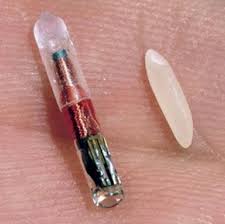 What many of these people who have these cards in their wallet or purse do not know is that very same technology that is used in these cards & RFID check-out readers can also be used to wirelessly skim your cards & personal data. It is the nature of this technology, RFID transmits your data over open airwaves.
What many of these people who have these cards in their wallet or purse do not know is that very same technology that is used in these cards & RFID check-out readers can also be used to wirelessly skim your cards & personal data. It is the nature of this technology, RFID transmits your data over open airwaves.
The early origins of this RFID technology lay in the cold war and was originally used as a spy tool. Now, this technology is used everywhere from inventory tracking (yes a tracking tool) to embedded in your pets or into your clothes. If you’re interested in how governments, companies & institutions want to you use this technology on you, then you should read this book called SPYCHIPS by Dr Katherine Albrecht who is the a global expert and champion of protecting your?privacy and exposing the truth & motives behind companies & governments wanting to implement this RFID technology. A truly interesting read.
Now we are not saying the convenience of this technology is not great nor are we saying that the financial institutions & governments who have implemented this technology are not trying to better secure it, what we are saying is we personally were not satisfied with the level of protection offered by the passive protective devices on the market that claim to supposedly protect your data from being wirelessly skimmed.
That is why we developed the world 1st Active RFID & NFC protective device called Armourcard, we do not try and block or shield RFID signals (passive) this method has varying degrees of success & often at most may simply reduce the distance you could be skimmed, but might not stop it.*
Armourcard ‘Actively’ powers up with its own battery (not relying on convection from the RFID reader) and emits a jamming forcefield that actually jams the most common frequency these contact-less devices communicate over of 13.56 MHz.
Find out why Armourcard is better here
We know there are a lot of different RFID protective devices on the market like RFID blocking wallets or shielding credit card sleeves that are passive, we developed Armourcard to personally protect our own data as we were concerned with the global roll-out of this technology and the limitations of passive protection offered in the marketplace.
If you want to protect your personal information from wireless skimming then Armourcard with its Active jamming technology is the superior choice.
BUY ARMOURCARD NOW
Source:
^Please note: Visa payWave, Mastercard PayPass & American Express ExpressPay are all registered trademarks of the afore mentioned relevant card issuing companies, These companies do not sponsor or officially endorse this website, Armourcard is independent & just protects these cards from being skimmed. *Passive Shields or metallic wallets Only reduce the signal strength, this will not block a high-powered RFID reader Source: Credit Card Fraud The contactless Generation | Kristin Paget | Chief Hacker, Recursion Ventures. Please note Kristin Paget does not sponsor or officially endorse this website or product, we have only referenced a report that is freely available online to download and read. All credit for the report and its findings go to Kristin Paget.
July 3rd, 2013
Rogue Smartphone Apps to skim your Credit Card Data.

APPetite for destruction, Apps that can Skim your credit card data
Not long ago I wrote a blog post on the new wave of smartphones that are NFC enabled that can use free apps to skim credit cards and the potential threat that anyone with a NFC enabled phone can potentially skim your credit cards. So protecting your credit cards from electronic pickpockets in this new age of NFC enabled phones just got a little bit more necessary.
 Now you have to think about every APP you download.
Now you have to think about every APP you download.
Because every APP could hold a Trojan program inside that runs in the background and basically searches via your NFC enabled smartphone for credit cards details.
The credit cards that use the RFID chip like Visa cards PayWave, MasterCard PayPass or American Express’s ExpresPay.
So next time you drop your phone inside your handbag or by your wallet watch out it may be your skimmers best friend.
Your phone with the rogue App installed will locate the RFID enabled cards, interrogate them for their data and secretly email those credit card numbers to a criminal 3rd party without you ever knowing it.
Pretty scary stuff isn’t it.
Well, the only way to protect yourself truly is to put an ARMOURCARD inside your wallet alongside all your RFID enabled credit / debit cards.
ARMOURCARD’s patented ACTIVE RFID & NFC protection actually jams all RFID & NFC signals running on the most common bandwidth for contact-less devices of 13.56Mhz.
So even if you have a rogue APP there is NO chance it could get your credit card data, ARMOURCARD would instantly power up when the APP would try and communicate with the cards and jam the signals.
 Isn’t it time you started to protect your own identity and data!
Isn’t it time you started to protect your own identity and data!
Walt, one of our US competitors is again on the PR trail and showing just how easy it is these days with trojan APPs.
We think Walt does a great job getting the message out there, so thanks, Walt.
We just don’t believe that passive RFID blocking wallets or shielding sleeves (like what Walt stocks) are the best way for protecting your data.
In-fact there are many reports by industries top hacking security experts* stating that these passive blocking wallets and sleeves at the very BEST may limit the distance too which a reader can read your cards but mostly if a reader is dialled up in power and antenna strength these passive RFID blocking wallets and sleeves WILL BE penetrated.
The choice is yours it’s your personal data, we chose active protection that is why we developed ARMOURCARD.
Get Protected Today BUY ARMOURCARD NOW!
Source^ Passive Shields or metallic wallets Only reduce the signal strength, this will not block a high-powered RFID reader Source: Credit Card Fraud The contactless Generation | Kristin Paget | Chief Hacker, Recursion Ventures. – See more at: https://armourcard.com/rfid-blocking/
July 2nd, 2013
Aluma Wallet – As seen on TV and by RFID skimmers ?

Aluma Wallet – PLUS a FREE set of Steak Knives
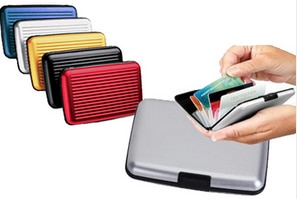 There are many RFID wallets on the market and none are as aggressive in their advertising as the Aluma Wallet.
There are many RFID wallets on the market and none are as aggressive in their advertising as the Aluma Wallet.
We applaud Aluma Wallet for helping educate the public on the issue of needing RFID protection, as most people either didn’t even know there was an issue or just never thought it would happen to them.
So first up…
well done for getting it out there.
Aluma Wallet quite rightly states several very real statistics on their infomercials and they believe that a hard aluminium cased wallet offers some level of protection against electronic pickpocketing.
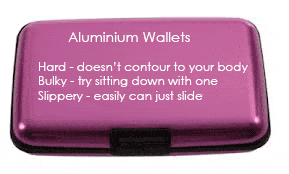 We at ARMOURCARD have done our own research and we were not satisfied that the level of protection these aluminium wallets like Aluma Wallet give actually prevents a dialled up power RFID reader from penetrating their metal cases.
We at ARMOURCARD have done our own research and we were not satisfied that the level of protection these aluminium wallets like Aluma Wallet give actually prevents a dialled up power RFID reader from penetrating their metal cases.
To us, they seem a little ‘analog’ and at the very best may limit the distance an RFID reader can interrogate your credit cards from, apart from the fact that they are ugly, bulky and can easily slip out of your pocket (so you may actually lose your wallet)
No that wasn’t just why we developed ARMOURCARD which offers our latest ‘patented Active RFID Protection’
 Plus the fact that with ARMOURCARD you can own any wallet you like and not be forced to buy any ugly RFID protection claiming wallet to get at least what is perceived to be some ‘passive’ protection.
Plus the fact that with ARMOURCARD you can own any wallet you like and not be forced to buy any ugly RFID protection claiming wallet to get at least what is perceived to be some ‘passive’ protection.
No we developed ARMOURCARD and patented our new ‘Active RFID Protection’ that actually jams the RFID & NFC signals so no queries from a reader regardless how powerful the reader is dialled up or how big the antenna is, will no circumvent ARMOURCARD’s jammng technology.
Now ask yourself this…
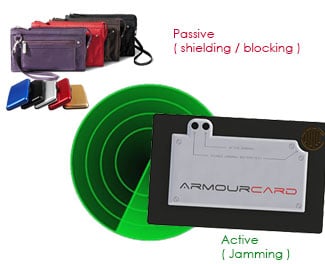 Do you want to be told to buy an ugly, bulky aluminium wallet that may or may not protect your personal data from electronic skimming
Do you want to be told to buy an ugly, bulky aluminium wallet that may or may not protect your personal data from electronic skimming
or
Do you want the latest ‘Active RFID Protection’ that actively tackles the problem differently and in better more secure way
NOT from passively, maybe, hopefully trying to block a signal?..
BUT actively jams all RFID & NFC signals using the most common bandwidth used for contact-less devices of 13.56Mhz.
We asked that same question and that is why we developed ARMOURCARD, to protect our own personal data,
Now you can protect yours.
Video: America Now News Report putting Aluma Wallets claims to the test
June 12th, 2013
The Australian Newspaper Article on electronic pickpocketing
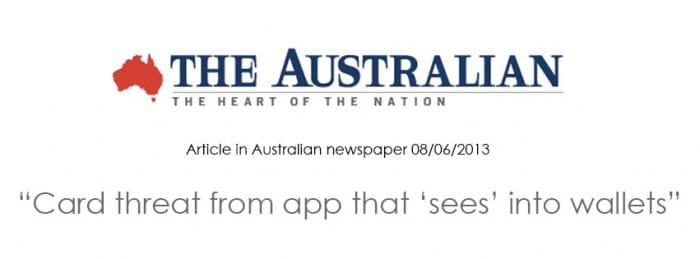
The Australian Newspaper runs a story on the new wave of electronic pickpocketing coming to a wallet near you.
In the weekend version of ‘The Australian’ newspaper (8.6.13), two reporters Adam Shand & Ben Westcott report on how electronic pickpocketing is now a real concern.
We applaud Adam, Ben and The Australian Newspaper for bringing this to the attention of the general public.
Now as we have reported in a previous ARMOURCARD blog post, there are now FREE apps that allow you to skim card data with your Near Field Enabled (NFC) smartphones. These include the Samsung Galaxy 3 or Galaxy 4, latest Windows phones and rumors are that the next generation of iPhone will also be NFC enabled. What that means to you and I is everyone with a smartphone potentially will be able to use that phone to electronically pickpocket your data without you even knowing it.
We did our own bench testing
At ARMOURCARD we don’t claim to be experts in hacking or skimming.? However we were able to download a range of apps that were capable of extracting card data and applied them to testing. We found that the apps were able to extract different data from a range of cards some even including the cardholders name . The point being that if a couple of novices could easily obtain the equipment and means to do this, what would a seasoned professional be capable of accomplishing? We were not comfortable with the ease at which our personal data could be compromised. ARMOURCARD provides the first electronic solution to this vulnerability.
What do the card issuers say:
In the article a spokes person for Visa, Judy Shaw, said that it was:
“technically possible to lift some details from its cards using NFC scanning technology”
In the article it was said that “the level of security was extremely high and contact-less payments were as safe as traditional cards”. Traditional cards do not have a history of being secure. The size of the fraud industry which has emerged from the lack of card security is living testament to this. Why else would financial institutions limit? transactions to under $100 if there was no cause for concern?? Does that sound secure to you?
If you are wanting to secure your identity today, then get ‘active RFID & NFC protection from ARMOURCARD.
Why risk your identity? Buy ARMOURCARD today!
To view the full article click on the image below.
May 10th, 2013
RFID a Spy Tool part 1

Radio-frequency identification (RFID) as a Spy tool of the future
A quick definition:
Radio-frequency identification (RFID) is the use of a wireless non-contact system that uses radio-frequency electromagnetic fields to transfer data from a tag attached to an object, for the purposes of automatic identification and tracking.
Put simply think of RFID as like your FM radio waves, they can penetrate walls, clothes, doors etc etc, with the right RFID reader you can trigger the interrogation of the RFID tag within your credit cards, ePassports, enhanced driver licenses, library cards etc etc. So RFID as a spy tool was how it got started.
Find out more about how RFID works here
Great Seal Bug or BUGATE – A cold war spy story
 RFID has been around since WWII and its primary function was for espionage or spying. There is a famous cold war instance whereby the KGB used this very same technology in 1945 to eavesdrop on the US Ambassador.
RFID has been around since WWII and its primary function was for espionage or spying. There is a famous cold war instance whereby the KGB used this very same technology in 1945 to eavesdrop on the US Ambassador.
The KGB used Russian school children to present a beautiful wooden carving of the seal of the United States of America to the US Ambassador Averall Harriman. He proudly displayed the plague in his embassy residential office, where it hung within earshot of America’s Cold War secrets.
The device consisted of eavesdropping apparatus that was dormant until activated by what was termed
fantastically advanced bit of applied electronics

Just like the RFID & NFC tags today, the trojan plaque’s device was powered by invisible radio waves.
It was powered up by high-frequency waves pointed from a van that was parked outside the embassy.
The beauty of this device is as did not require a battery to work and if the radio waves were not directed at it, the device lay dormant, so detection was very hard if not actively transmitting.
Hence why it took 6 years to discover it.
To discover more about how vulnerable you are with your RFID / NFC enabled cards / epassports etc go here
Buy ARMOURCARD now and get protected from this type of electronic spying
